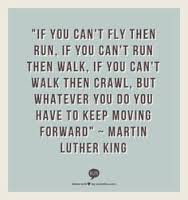
My definition of leadership is “taking a group where they need to go.” But a portion of leadership is helping them to understand whythey need to go and to help them want to go. Otherwise when you lead no one follows. And if no one followed, you have not really led.
That is why I encourage teachers and leaders to consider three words: Crawl, Walk, and Run. Where are your members related to the change or new behavior toward which you are leading them?
- Are they at the Crawl stage (afraid, in the dark, never done it)?
- Or are they at the Walk stage (understand, not done it much, interested but still not confident)?
- Or are they at the Run stage (love it, want more, waiting for permission to take off)?
Leaders tend to think everyone is at the same stage as they are. Frequently that means leaders try to lead Run actions. But if members are at the Crawl stage, they won’t be following when you look back. You cannot expect a brand new baby to run.
For example, a class that has never witnessed to someone is unlikely to do so just because the teacher challenges them to do so. But they likely would take a step in that direction if the teacher asked them to pray for a lost person. That would be a Crawl action. Sending a postcard might be Crawl. Making a phone call might be Walk. Making a visit with a classmate might be Walk. Sharing Jesus with someone alone might be Run.
Now, what does that have to do with making change in your Sunday School lesson? You have to make changes in teaching in the same way.
Many teachers are lecturers. Sometimes they ask the class questions and the same one or two give responses. In order to make changes, you have to avoid introducing too much too fast. I tend to recommend adding one new method and using it for 5 minutes or less. Use the same method for a 4-6 weeks, keeping it short. Then change the method, keeping its use short. This is the Crawl stage.
Don’t be deterred by negative feedback; explain why it is important. But also watch to see which methods participants respond to more positively (are more talkative and animated). In the first few months, lean more toward those methods which get the most positive response.
When they seem to be accepting that your teaching includes a method besides lecture, then feel comfortable to make a change toward the Walk stage by lengthening the time you use a new method or by adding a second method during the hour. When adding a second one, keep it short.
As an example. as they enter the classroom, give members an index card with a question and ask them to write down answers. When it is time for the lesson to start (after welcome, announcements, and prayer), then ask them to share their answers. Make the question related to the lesson for that day–it might even come from the lesson. Don’t make it too deep. Make sure it is not a yes/no or one word question. The point is to get them talking. Keep the activity short (five minutes or less). Then move on to teaching the normal way. Do the same type of activity for the entire month.
Leadership means you have to be brave to lead them where they need to go. And it means you have to keep leading, even when you are not sure you are making progress. Since learners have a variety of learning styles, it is important to vary our teaching methods in order to address those learning styles.
When we do so, it grabs their attention, it increases their involvement, and it ensures greater retention of what they learned. And if they remember the lesson and truth more, they are more likely to live it out. Isn’t that what we are after? Lead toward lesson change. Make disciples. Be revolutionary!
Leave a Reply